There are many different uses, needs, industries and disciplines involved in water which are influenced by separate values and meanings of its users. Essentially, you can have a biologist, lawyer and engineer working in the field of water for entirely different or similar reasons. As Alberta’s legislature welcomes both new and returning MLA’s, we’ve outlined 10 points that both politicians, and all Albertans, would benefit to know about water in Alberta.
1. There are seven major watersheds (also called river basins) in Alberta.
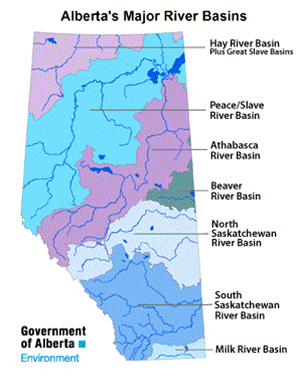 |
| Our major River Basins, from the Government of Alberta |
A watershed or river basin is defined as an area of land that catches precipitation and drains it to a water body, such as a marsh, lake, stream or river [1]. The seven major basins in Alberta are [2]:
- Hay River Basin
- Peace/Slave River Basins
- Athabasca River Basin
- Beaver River Basin
- North Saskatchewan River Basin
- South Saskatchewan River Basin
- Milk River Basin
Travelling through these different river basins our water eventually ends up in the Arctic Ocean, Hudson’s Bay, or the Gulf of Mexico.
2. Alberta is estimated to have more groundwater than surface water, but we don’t know enough about it.
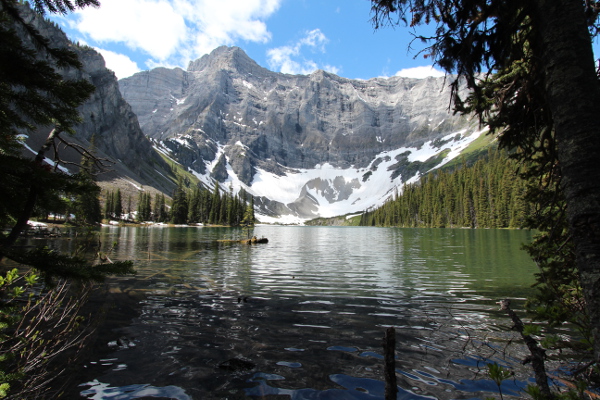 |
| “Rawson Lake Kananaskis country Alberta Canada July 2014” by davebloggs007 is licenced under CC BY 2.0. |
Aquifers are recharged as water is absorbed at the Earth’s surface and makes it way down to where the aquifers are located. Approximately 90 percent of rural Albertans rely on groundwater wells for their primary source of water supply. Licenses for groundwater use make up approximately 26 percent of all water licenses currently issued, thus making groundwater an important source of water for Albertans [3]. Despite this high reliance on groundwater, knowledge of just how much of this resource exists is lacking therefore making it difficult to drill new wells for individual, municipal and industrial use [4].
3. Water doesn’t stop at the border, so Alberta has agreements with our neighbours.
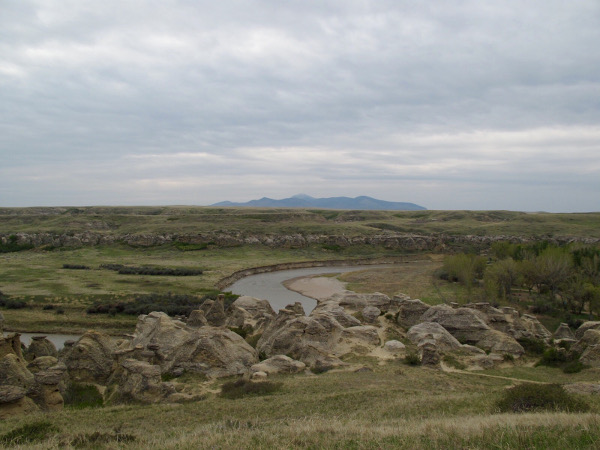 |
| “Milk River” by tuchodi is licenced under CC BY 2.0. |
Alberta is a landlocked province with river systems that cross political boundaries. To manage this transboundary water, neighbouring jurisdictions such as B.C., the Northwest Territories and Saskatchewan have agreements with Alberta to manage water quality and quantity expectations. Alberta also has an agreement with Montana to regulate the flow of the St Mary and Milk Rivers that are shared between both jurisdictions.
4. Water Licences are honoured on a priority basis.
 |
| “St. Mary Irrigation” by Calypso Orchid is licenced under CC BY 2.0. |
The core principle of water management in Alberta is that water is owned and managed by the Government of Alberta and its use is allocated through a system of decisions and conditions that are recorded in licenses. Licences are issued with priority numbers based either on time of application or as predetermined by Ministerial Order, which enable those holding senior water licences to defend their allocations in the event of a drought, or other circumstances where water supplies are limited. The priority system is designed to provide stability for infrastructure investment in municipalities, industry, agriculture and other uses, as well as provide several mechanisms for re-allocation as growth in demand occurs.
5. The majority of Alberta’s water is located far away from the majority of Alberta’s population.
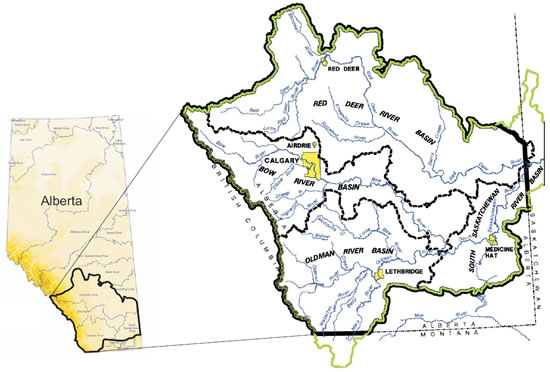 |
| Most of Alberta’s population is in the South Saskatchewan River Basin, from the Government of Alberta. |
Over 80 per cent of Alberta’s water supply is in the northern part of the province, while 80 per cent of water demand is in the south [5, 6].
Most of Alberta’s water quantity problems are in the southern part of the province. The South Saskatchewan River Basin (SSRB), which is home to the majority of Alberta’s population, is the only basin in Alberta that is closed due to limited water resources. This means that no new water licenses can be issued to municipalities or companies looking to withdraw water from the rivers in the basin. While this is problematic for new water users and has impacted growth in some municipalities, this approach can help mitigate drought issues in the region.
6. Alberta is susceptible to both flooding and drought.
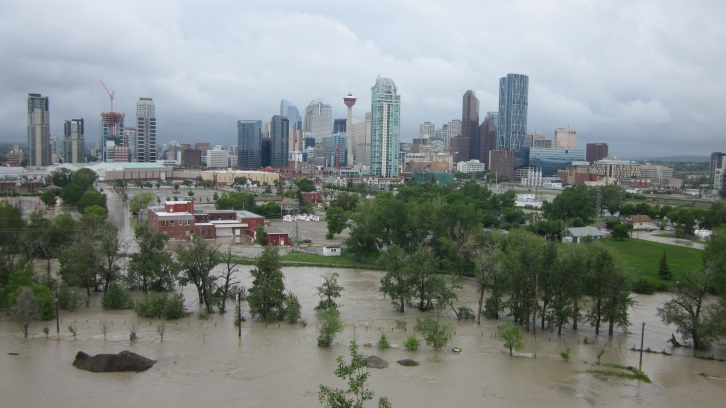 |
| 2013 Flooding in Calgary |
Alberta’s lakes and rivers are susceptible to flooding, especially in the spring season when snowmelt and rain storms frequently occur. However before the flood of 2013 many water users were more concerned about drought. Drought is a major concern in Alberta where long periods of drought can complicate farming practices, electricity production from hydro-power and challenge overall water management and allocation.
7. Water reuse and rainwater harvesting are viable water management solutions.
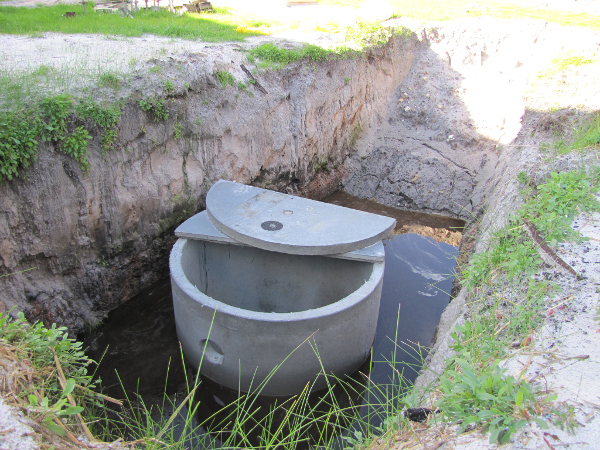 |
| “Grey Water Tank – Strawbale House Build in Redmond Western Australia” by Brett and Sue Coulstock is licenced under CC BY 2.0. |
If drinking reused water is good enough for Chris Hadfield it should be good enough for the rest of us – but it’s complicated. In river basins with limited water resources and exposure to drought, water management practices ensure water is provided to where it is needed. Water reuse is one solution for mitigating drought, however, there is significant policy and regulatory issues that require attention before this solution can be implemented.
8. First Nations communities have a sacred relationship with water.
In the film Water: the Sacred Relationship water is described as sacred to First Nations people. The film also touches on the need to respect this precious resource for future generations. While water management for First Nations falls under federal government jurisdiction, there is a role for Alberta’s government, municipalities and industries to pursue meaningful engagement that includes First Nations communities and their valuable perspective of water.
9. Water issues are diverse and complex resulting in multidisciplinary solutions.
| |
| 11 WPACs in Alberta |
There are many organizations, groups and individuals committed to improving water management in Alberta. These include Watershed Planning and Advisory Councils (WPACs), Environmental Non-Governmental Organizations (ENGOs), industry organizations, research groups, government departments and groups, as well as everyday citizens.
– WPACs are multi-stakeholder, non-profit organizations that assess the conditions of their watershed and develop plans and activities to address watershed issues. There are eleven WPACs in Alberta.
– ENGOs offer training, assistance, and information to help address issues in water management. There are many ENGOs that focus on water management in Alberta. Click here for a short list.
– Industry organizations exist as collaborative hubs where companies and industry partners may share best practices and advance their knowledge on various topics including water management. Click here for a list.
– Research groups and government departments that focus on water and the management of this resource include Alberta Innovates – Energy and Environment Solutions (AI-EES), the Alberta Water Council, Alberta Environment and Sustainable Resource Development (ESRD), and the Environmental Law Centre (ELC).
10. Alberta is working to prevent the spread of invasive mussels.
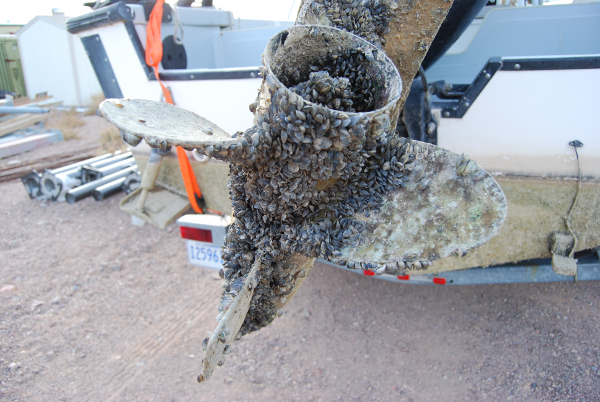 |
| “Aquatic Invasive Species: Mussel fouled propeller from Lake Mead, Arizona” by Government of Alberta is licenced under CC BY 2.0. |
Zebra and quagga mussels are an invasive aquatic species that have spread throughout the Western United States and Eastern Canada. Once they are introduced they can negatively impact the health of a water body and can wreak havoc on water and agricultural infrastructure. The Government of Alberta is working hard to prevent invasive mussels from entering the province. In 2014 specially trained sniffer dogs inspected boats entering the province and in 2015 boat inspections become mandatory. If you are traveling this summer, be sure to clean, drain and dry your boat and be prepared for boat inspections.
We came up with a list of 10 however it would be easy to come up with a list of 100. Add below what you believe incoming MLAs must know about Alberta’s water.
[1] Government of Alberta. “Water Quantity in Alberta”. Alberta Environment and Sustainable Resource Development. Retrieved from: http://www.waterforlife.alberta.ca/02806.html
[2] http://www.waterforlife.alberta.ca/02806.html
[3] Government of Alberta. 2010. “Facts About Water in Alberta”. Retrieved from: http://environment.gov.ab.ca/info/library/6364.pdf
[4] Picture reference: https://www.twdb.texas.gov/groundwater/
[5] Government of Alberta. 2010. “Facts About Water in Alberta”. Retrieved from: http://environment.gov.ab.ca/info/library/6364.pdf
[6] http://esrd.alberta.ca/water/programs-and-services/south-saskatchewan-river-basin-water-information/default.aspx
